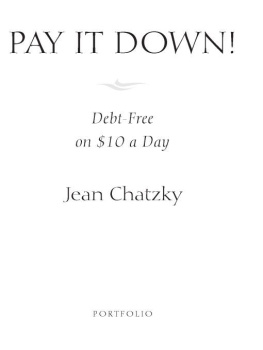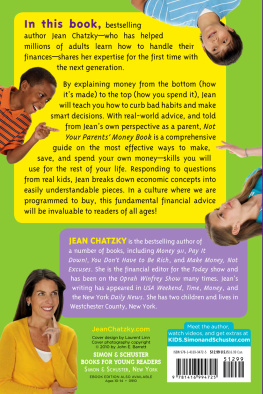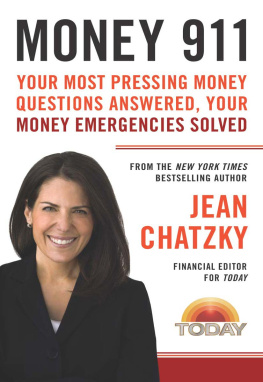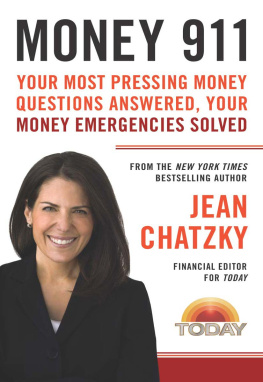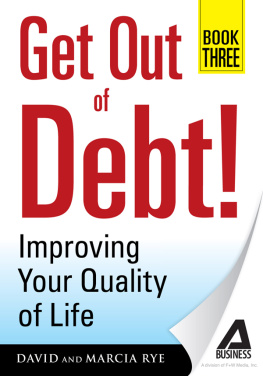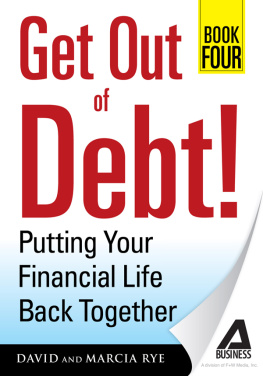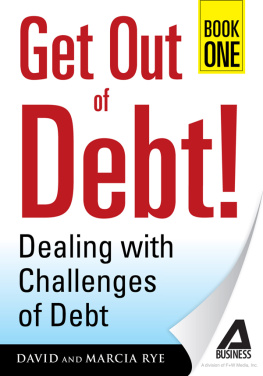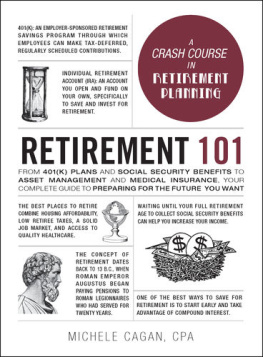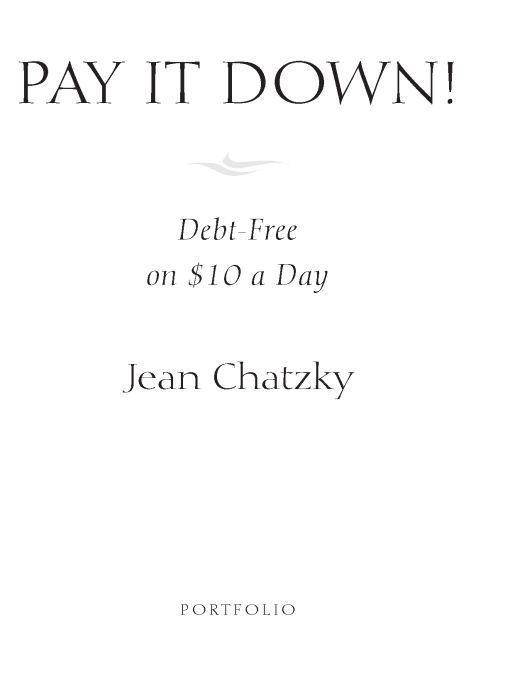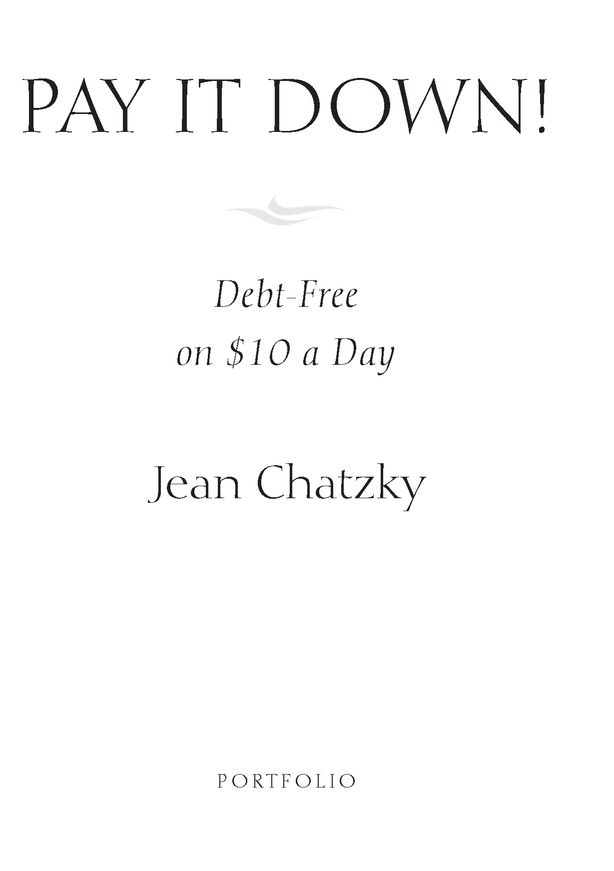Table of Contents
PORTFOLIO PAY IT DOWN!
Jean Chatzky is the financial editor for NBCs Today, a contributing editor for More magazine, a columnist for New York Daily News, and a contributor to The Oprah Winfrey Show.
She is the author of six books, including The Difference: How Anyone Can Prosper in Even the Toughest Times (Crown Business) and the Wall Street Journal and New York Times best seller Make Money, Not Excuses.
She blogs on jeanchatzky.com.
For anyone who
deserves a new beginning
THE PROMISE: RENEWED
HOW WOULD you like to be free of overwhelming credit card debt? To have a financial cushion to fall back on? To know you have the skills to save and invest for any goaland to guarantee your financial future?
I wrote those sentences for the first time six years ago, during more pleasant financial times. The stock market was chugging along nicely. The housing market, doing better than that. Americans were feeling more than flush and as a result many of us were living larger than ever. We outfitted our homes with better appliances, took fancier vacations, added another car to the driveway (or another bay to the garage)-and did it all on borrowed money Credit cards and home equity lines paved the way. As a country we werent worriedevery time we turned around it seemed that we were wealthier on paper than we had been the day before.
And yet, I had a nagging feeling that this was all a house of cards about to come tumbling down. I felt it for the first time on January 19, 2001. That was the day I opened my New York Times to find a story by Louis Uchitelle noting that Americans had less equity in their homes than at any time since the Great Depression. I started digging and found that rising mortgage debt wasnt the only symptom. Fewer of us owned our cars than at any time in the past. Our average household debts on student loans and credit cards were setting new records as well.
And so I dug in to write Pay It Down!, a book I was sure Americans were going to need immediately.
I was ahead of my time.
The Rx for getting out of debt laid out in these pages worked then-as it works now. The hundreds of thousands of readers as well as the million people who participated in the Debt Diet on The Oprah Winfrey Show (based largely on the information in this book) can attest to that. But too many people werent ready to listen.
(To show you how ready you are to get out of debt, I now have an online program to help you wherever you are at: not ready, getting ready, or ready. This program respects where you are at and works with you to maximize your success. The program is a result of my collaboration with James O. Prochaska and Pro-Change and brings the science of behavior change to you. Youll find more information at jeanchatzky.com.)
Then, as the economy twisted and turned, it became clear that only those individuals who minimized their debt and maximized their savings had a shot at a stable financial future. And along the way some of the rules of the road have changed. So I decided to update Pay
It Down!, because you need different strategies than you needed a mere half decade ago, whether youre trying to:
Negotiate with your creditors
Refinance or modify your mortgage
Increase your credit score
Manage your student loans
Work with a credit counselor
Or simply maintain a decent balance
between good debt and bad
I give them to you here in the same straightforward, easy-to-stomach way I try to present all of my financial solutions. Life is tough enough without having to wade through pages of unnecessary lingo. And despite the fact that time has passed, the Promise remains the same:
How would you like to be free of overwhelming credit card debt? To have a financial cushion to fall back on? To know you have the skills to save and invest for any goaland to guarantee your financial future?
I can give you that. Even in these tough credit markets. Even in this economy I can give you that for $10 a day. And if that sounds like very little-well, it is.
Its a movie for one, without popcorn.
Its lunch at McDonalds for two children.
Its skipping the car wash and washing the car in your driveway instead.
Its so many of those things that you can do without. But its also the key to your future. Lets say youre the average American. You have a decent job, but you also have $7,200 in high-rate credit card debt. You have no savings to speak of. You worry about your money on a daily basis (in fact, it keeps you up at night), and you dont believe that $10 a day can dig you out of that hole. But it can, and in less time than you may think. If you get on this plan-and stick with it:
In three years youll be free of credit cards. By applying that $10 a day against your $7,200 credit card debt (at an interest rate of 16 percent), youll be debt-free in two years and five months, or twenty-nine months total.
In five years youll have a financial cushion. Once the debt is gone, you can start saving that $10 a day for your future. Youll put it in a money-market account. It wont earn much in interest while its sitting there (I used a 2-percent interest rate for this example), but theres no risk youll lose it either. Five years from the time you started socking away your $10 a day, youll have a fat emergency cushionnearly $10,000. Thats your insurance against a layoff, an illness, even a leaky roof or other financial mishap that comes your way.
In ten years youll have a nest egg for retirement. After your emergency cushion is in place, you can start investing your $10 a day so that it can work harder and grow faster for your benefit. If you put it somewhere that it can grow tax-freesuch as in a 401(k) accountand you earn, on that money, the 9.44 percent that the S&P 500 has returned between 1926 and today, in ten years (in addition to your emergency cushion), youll have $23,653; in fifteen years from the day you opened that account, youll have $61,505; in twenty years, youll have $122,076; in twenty-five years, youll have $219,004; in thirty years, youll have $374,112; in thirty-five years, youll have $622,323; and in forty years, youll have $1,019,519.
More than $1 million on $10 a day. Even in these times, these markets, this economy? Yes, even after the last eighteen months, investing for the long term in the S&P 500 still stands the test of time. The average annual return going all the way back to the Great Depression is 9.44 percent. Thats better than bonds, better than cash. Thats real money in anybodys book.
It sounds simple, and it is. All thats standing in your way is knowledge. You need to know how to free up that $10 a day. You need to know how to get yourself to do that every day, without fail, for the rest of your life. And you need to know how to guarantee that that money gets to where its supposed to be so that it can work its magic for you.
The answers are in the next two hundred and fifty pages. Read on.
Introduction: Getting Ahead and Staying Ahead
52 million times a day
2.2 million times an hour
36,242 times a minute
604 times a second
Thats how often we use our credit cards in this country. Thats how often we whip out our slim pieces of plastic and slide them through the little electronic slots or hand them over to the cashier. We type the numbers into our browsers or read them hurriedly to a clerk over the telephone to buy books, groceries, or movie tickets, or even to foot the bill for the copayment at the pedia tricians office. We do it so often, we dont even think about it anymore.

